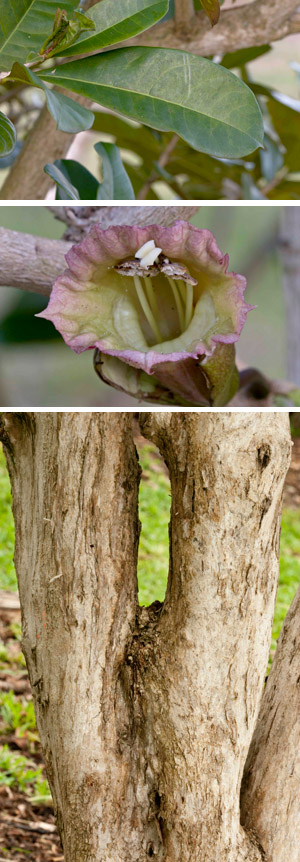Plants of South Florida · Plants by Conservation Area · Plants by County · Plants by Habitat Quick Search · Advanced Search |
||
|
|
||
 |
Amphitecna latifolia (P. Mill.) A.H. Gentry Black-calabash |
|
|
South Florida Status: Critically imperiled. Four occurrences in four conservation areas (Alice Wainwright Park; John D. MacArthur Park; Sewell Park; Simpson Park). Taxonomy: Dicotyledon; Bignoniaceae. Habit: Tree or large shrub. Distribution: South Florida, the West Indies, Mexico, Central America, and South America. South Florida Distribution: Miami-Dade and Palm Beach counties. South Florida Habitats: Coastal hammocks. Protection Status: Sargent (1922) has an illustration. Aids to Identification: Not listed by any agency. References: Sargent, 1894; Small, 1933a; Long & Lakela, 1976; Little, 1978; Gentry, 1980; Richardson, 1984; Austin, 1992; Austin, 1995; Nelson, 1994; Wunderlin, 1998; Liogier & Martorell, 2000. Synonyms: Crescentia cucurbitina L., Crescentia obovata Benth., Enallagma latifolia (Mill.) Small. Historical Context: James G. Cooper first collected black calabash in 1859 at Fort Dallas (s.n., NY; Sargent, 1894), which was located north of the Miami River within the present-day Miami. Other early collections were made from “Miami” or “shore of Bay Biscayne” by Abram P. Garber in 1877 (59, NY; 69, NY), and Allan H. Curtiss in 1897 (5838, NY). Some of these collections probably were from Brickell Hammock, south of the Miami River. Specimens definitely were collected in Brickell Hammock as early as 1911 by John Kunkel Small and others (3293, NY), and as late as 1969 by Robert W. Long (2829, USF). Other specimens were collected in 1920 by J.P. Young (413, US) and Harold N. Moldenke (721, NY). Plants still are present in fragments of Brickell Hammock at Sewell Park, where Bradley observed a single tree in 2000, at Alice Wainwright Park, where it was recorded by Roger L. Hammer (1996a), and at Simpson Park, where it was first reported by John Popenoe in 1973 (Avery’s Notes, 4 June 1973). Also, Popenoe reported plants to be present in a private property adjacent to Vizcaya, but much of that hammock was damaged in the early and middle 1990s. Plants may no longer be present there. Black calabash also was known from along the Little River in Miami-Dade County, about 5 miles north of Brickell Hammock. Joseph H. Simpson first collected it there in 1892 (540, NY, US), and Nathaniel L. Britton collected it there in 1904 (451, NY). This area has been completely developed. Small and others also made a single collection in “Freeman Hammock, Arch Creek Prairie” in 1915 (6767, NY), a station about 4 miles farther north. In 1999, Woodmansee observed a cultivated plant at Enchanted Forest Park, which is located next to what is now Arch Creek Park. In 1904, Small made a single collection on the western side of Elliott Key in Miami-Dade County (s.n., NY). Despite a great deal of botanical activity on the island, this is the only report known from that island. In 1916, Small also made a collection in a hammock west of the historical train station at Kendall in southern Miami-Dade County (7872, NY), possibly at what is now Kendall Indian Hammocks Park. This is the only report we have seen from that area. In 1975, Donald R. Richardson and Daniel F. Austin discovered black calabash for the first time outside of Miami-Dade County (Richardson, 1984; Austin, 1992). This population was found on a shell mound at John D. MacArthur Beach State Park in Palm Beach County, and was vouchered by Richardson in 1977 (s.n., FAU) and again in 1984 by Richard E. Roberts (s.n., USF). This station was observed in 1998 by Gann and Florida Park Service biologist Janice A. Duquesnel. Black calabash is widely cultivated in southeastern Florida, including at several conservation areas. At present, it is not known to have naturalized outside of its historical range. Major Threats: Exotic pest plant invasions. Comments: Considerable debate has focused on the nativity of this species in Florida. Austin (1992, 1995) provides excellent reviews of this debate, and further fuels the fire. We feel that the species is native based upon the abundance of herbarium specimens, from 1859 through the early 1900s, from many regions of Miami-Dade County. Further support for the nativity of this species is presented by Austin (1995) in which plants were reported to fruit regularly, even in the apparent absence of the species’ primary pollinators, nectivorous bats, which do not occur in Florida. The species may have been utilized and cultivated by the Tequesta tribe of Native Americans. Recommendations: • Survey Elliott Key in Biscayne National Park. • Map and monitor known stations on a regular basis. • Conduct conservation biology research and conservation horticulture studies, especially regarding pollination and dispersal. • Consider augmenting known populations at Alice Wainwright Park, Sewell Park, and Simpson Park. • Consider introducing other populations within its historical range, at Arch Creek Park, Enchanted Forest Park, Kendall Indian Hammocks Park, and Vizcaya Museum and Gardens. • Review for listing by FDACS and FNAI. |
||



